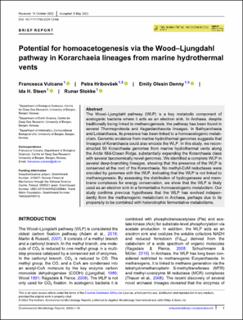| dc.contributor.author | Vulcano, Francesca | |
| dc.contributor.author | Hribovšek, Petra | |
| dc.contributor.author | Denny, Emily Maria | |
| dc.contributor.author | Steen, Ida Helene | |
| dc.contributor.author | Stokke, Runar | |
| dc.date.accessioned | 2023-08-09T13:20:59Z | |
| dc.date.available | 2023-08-09T13:20:59Z | |
| dc.date.created | 2023-06-10T20:07:53Z | |
| dc.date.issued | 2023 | |
| dc.identifier.issn | 1758-2229 | |
| dc.identifier.uri | https://hdl.handle.net/11250/3083222 | |
| dc.description.abstract | The Wood–Ljungdahl pathway (WLP) is a key metabolic component of acetogenic bacteria where it acts as an electron sink. In Archaea, despite traditionally being linked to methanogenesis, the pathway has been found in several Thermoproteota and Asgardarchaeota lineages. In Bathyarchaeia and Lokiarchaeia, its presence has been linked to a homoacetogenic metabolism. Genomic evidence from marine hydrothermal genomes suggests that lineages of Korarchaeia could also encode the WLP. In this study, we reconstructed 50 Korarchaeia genomes from marine hydrothermal vents along the Arctic Mid-Ocean Ridge, substantially expanding the Korarchaeia class with several taxonomically novel genomes. We identified a complete WLP in several deep-branching lineages, showing that the presence of the WLP is conserved at the root of the Korarchaeia. No methyl-CoM reductases were encoded by genomes with the WLP, indicating that the WLP is not linked to methanogenesis. By assessing the distribution of hydrogenases and membrane complexes for energy conservation, we show that the WLP is likely used as an electron sink in a fermentative homoacetogenic metabolism. Our study confirms previous hypotheses that the WLP has evolved independently from the methanogenic metabolism in Archaea, perhaps due to its propensity to be combined with heterotrophic fermentative metabolisms. | en_US |
| dc.language.iso | eng | en_US |
| dc.publisher | Wiley | en_US |
| dc.rights | Navngivelse 4.0 Internasjonal | * |
| dc.rights.uri | http://creativecommons.org/licenses/by/4.0/deed.no | * |
| dc.title | Potential for homoacetogenesis via the Wood–Ljungdahl pathway in Korarchaeia lineages from marine hydrothermal vents | en_US |
| dc.type | Journal article | en_US |
| dc.type | Peer reviewed | en_US |
| dc.description.version | publishedVersion | en_US |
| dc.rights.holder | Copyright 2023 the authors | en_US |
| cristin.ispublished | true | |
| cristin.fulltext | original | |
| cristin.qualitycode | 1 | |
| dc.identifier.doi | 10.1111/1758-2229.13168 | |
| dc.identifier.cristin | 2153438 | |
| dc.source.journal | Environmental Microbiology Reports | en_US |
| dc.relation.project | Trond Mohn stiftelse: TMS2020TMT13 | en_US |
| dc.relation.project | Norges forskningsråd: 315427 | en_US |
| dc.identifier.citation | Environmental Microbiology Reports. 2023. | en_US |

